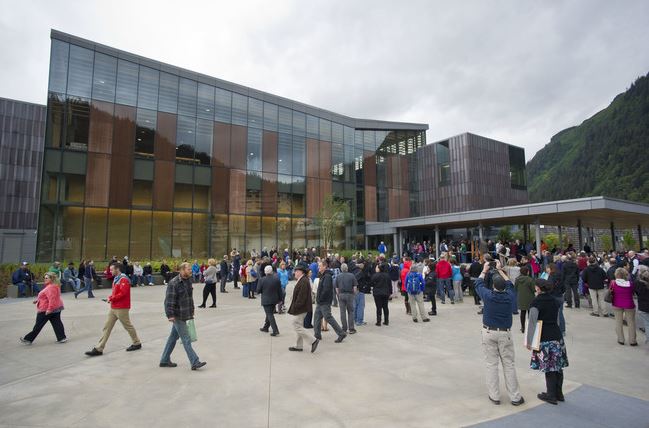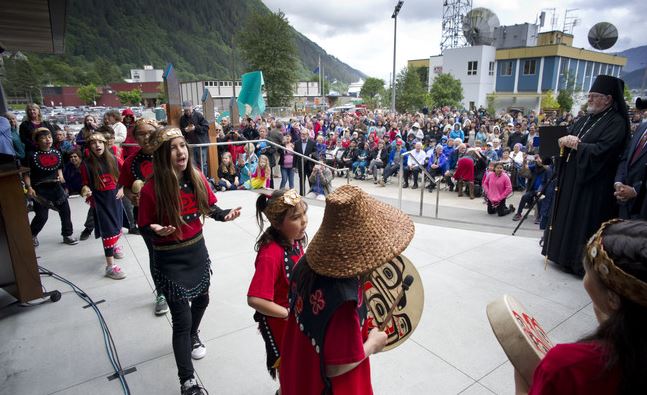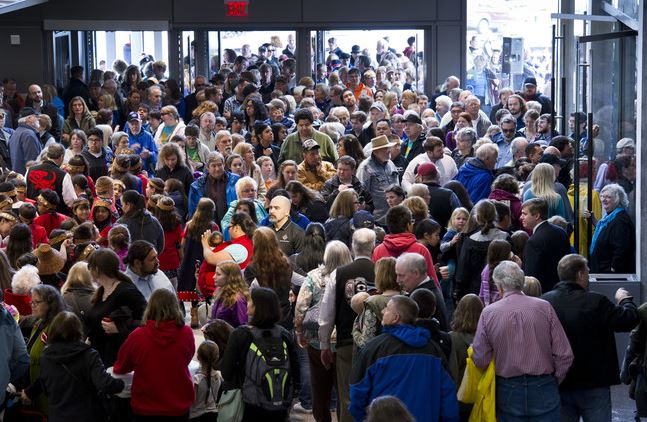
The writer evidently ‘forgot’ to mention that Andrew Kashevaroff was an Alaskan Orthodox priest, or that the current bishop of Alaska, Bishop David of Sitka and All Alaska, gave the invocation. May Fr. Andrew’s memory be eternal!
by James Brooks

Bishop David of Sitka and All Alaska observes the ceremonies after giving the invocation
After 12 years and about $140 million in development, Alaska has a new state museum.
The Andrew P. Kashevaroff State Library, Archives and Museum, affectionately known as the SLAM, officially opened after an hourlong ceremony featuring speeches from state dignitaries and song and dance from the Harborview Elementary School Tlingit Culture and Language Literacy Program. Hundreds of people filled the plaza outside the new building, standing under a cloud-dappled sky that occasionally dropped rain showers. The clouds parted just as Sen. Dennis Egan, D-Juneau, rose to speak.
“This is a moment that will be marked in Alaska’s history by what is happening today,” Gov. Bill Walker told the crowd. “This building is absolutely phenomenal by what it represents.”
What it represents is a long-term commitment. Bob Banghart, deputy director of the state division of Libraries, Archives and Museums, has repeatedly said the new building — which combines the services of the capital’s museum, archives and library into one structure — can last 100 years.
The previous museum, built on the same location in time for the 1967 Alaska Centennial, lasted just shy of 50 years. It was torn down in 2014 as construction of the new building progressed.
“This building ate it,” Lt. Gov. Byron Mallott said of the old museum, “and it has digested it well.”
At 118,000 square feet, the SLAM is seven times as large as the old museum, and it was intended to have space for 50 years’ worth of new collections. The closure of the National Archives office in Anchorage took up some of that room with transferred items, but there’s plenty of room to grow.

The building is one of the last significant state projects to be funded with money collected and allocated in the 2008 oil boom.
“One thing I’ll say about this building: Timing is everything, and it was really good timing by somebody’s part. We can afford to cut the ribbon,” Walker said.
Many lawmakers were in attendance at the ceremony, and Mallott alluded to their presence and the state’s current fiscal situation.
He said the building
“celebrates what, if we make the right choices about our future in coming days, we can celebrate both collectively, symbolically and really when we say, Alaska can build the most beautiful edifices.”
Museum conservator Ellen Carrlee was in the audience, listening to the speeches given by the governor, lieutenant governor and eight others.
In her hands, she held a framed picture of the decorative panels that adorned the old museum. It was given to her by a friend on the new museum’s opening day to commemorate the years of work involved in the new building’s construction and outfitting.
“It’s a huge relief to finally be here,” she said. “It’s like studying for a big exam: You study and you study — you could always study a little more — but to have it be here is tremendous. It’s not all the way done, but we couldn’t keep people out any longer. People want in, they want to see it.”
When the Harborview students finished their dancing and cut the celebratory ribbon, a crowd surged through the museum’s front entrance and into the gallery.
In front of one case, Juneau resident and temporary museum employee Tanna Peters explained the artifact mounts she’s been working on for the past year and a half. Curators from across the state were brought to the museum two years ago to help move artifacts into storage and to draft plans for the displays that now make up the museum’s permanent gallery.
To a regular visitor, the gallery looks complete. To a curator’s eye, however, there’s still things to do. Peters pointed out one display, where two artifacts were slightly touching — a no-no where preservation is involved. Pull-out drawers in some display cases are still empty, and the vendors in charge of the museum bookstore and cafe have not yet moved in.
Banghart said, however, that for all intents and purposes, the museum is complete. There might be a few little things to fine-tune, but it’s nothing that will keep the public from enjoying it.
David Shumway and Ken Ratcliffe, standing in the permanent gallery, couldn’t help but agree. For the past several years, Shumway has worked as the project’s mechanical engineer. Ratcliffe was its electrical engineer.
“This is a one-in-a-lifetime project for us,” Ratcliffe said.
To understand why, you have to look inside the museum’s walls, at things a normal visitor will never see. Museums and archives demand precision care, even with something you might take for granted — like the way the air moves in the building.
“There’s five separate and distinct environments in one building that are almost unnoticeable except for the Archives; they’re at 55 degrees,” Shumway said.
To understand, Shumway offered a suggestion: stand in the lobby for a few minutes and feel the temperature and humidity. Next, walk into the gallery and do the same. It’s much more humid, and it’s designed that way to protect the artifacts.

The lighting operates under the same principle — bright and inviting in the lobby and open spaces, but dimmer in the display cases to protect light-sensitive objects.
Shumway said fine-tuning each element of the building will take a little while longer. Plans are one thing, but actually having people in the building is something else.
To 5-year-old Eddy Seifert, however, the only thing filling his eyes was the mining locomotive in one corner of the gallery, with a section of the trans-Alaska Pipeline System towering overhead.
“This is my favorite thing, because it’s new,” he said with arms outstretched, indicating the entire building.
His mother, Shannon, laughed.
“We just walked through the doors,” she said. “I’m amazed how huge this is. I can’t wait to explore all the little nooks and crannies.”
The state museum is open seven days a week, 9 a.m. to 5 p.m. The state library and archives are open during working hours on weekdays.
Admission is $12, $11 for seniors and children are admitted free during the summer. A season pass is $25, according to a rate increase approved last year.
New State Museum Named for Orthodox Priest Opens in Juneau, Alaska

Leave a Reply